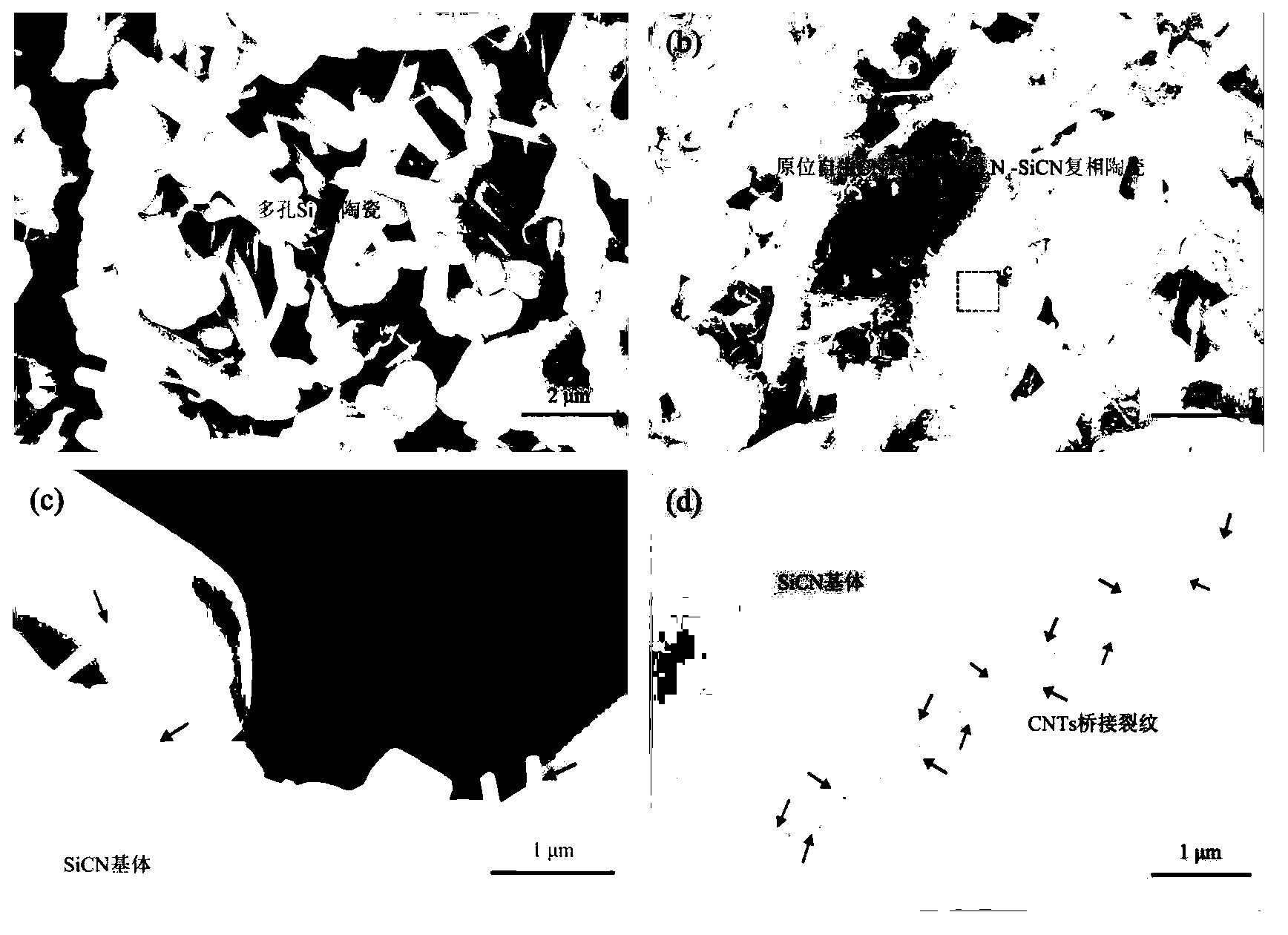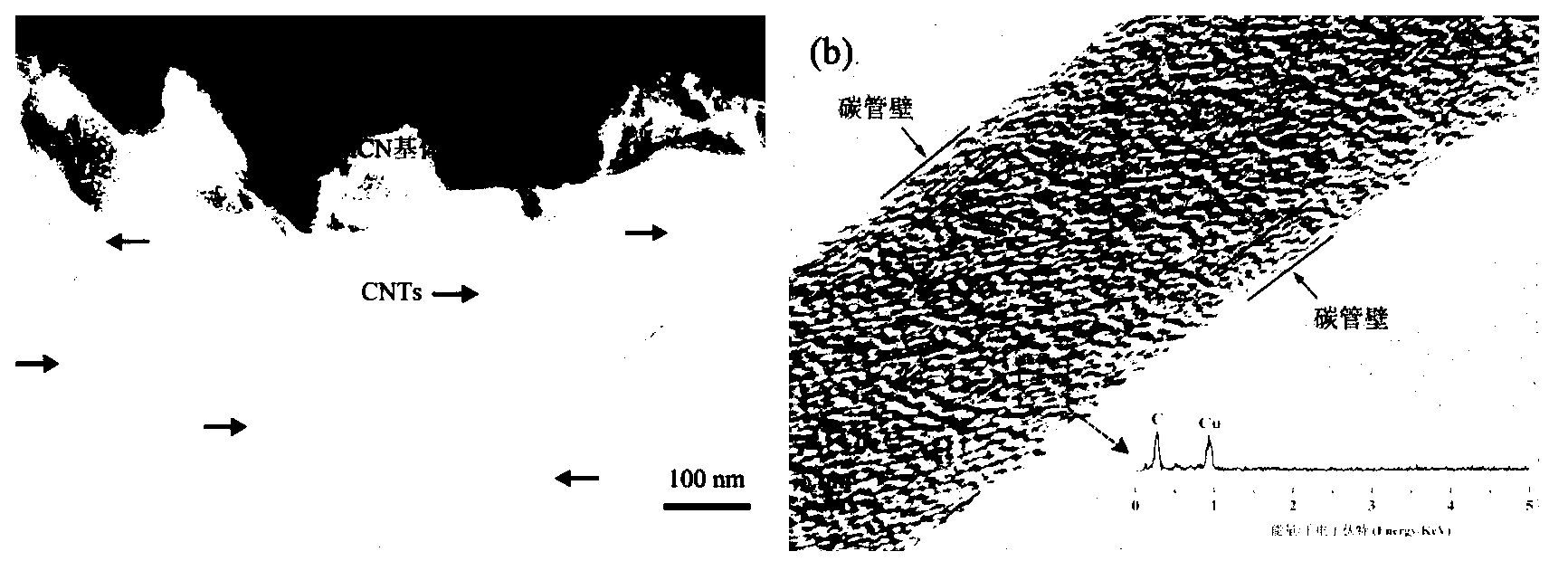Preparation method of in-situ synthesized carbon nano-tube modified SiCN ceramic matrix composite material
A carbon nanotube modification and silicon carbon nitride ceramic technology is applied in the field of preparation of in-situ carbon nanotube modified silicon carbon nitride ceramic matrix composite materials, which can solve the problem that CNTs and SiCN ceramic matrix cannot be generated synchronously, and achieve The effect of short preparation period, integration and simple process
- Summary
- Abstract
- Description
- Claims
- Application Information
AI Technical Summary
Problems solved by technology
Method used
Image
Examples
Embodiment 1
[0025] (1) Select porous Si with an open porosity of 50% 3 N 4 Ceramic substrate (22.86×10.16×2.00mm 3 ) as the base material.
[0026] (2) Using the vacuum impregnation process (vacuuming for 5 minutes, impregnating for 30 minutes), the mass fraction of 1.5wt.% Fe(NO 3 ) 3 9H 2 O acetone solution introduced porous Si 3 N 4 Porcelain interior, then air dry.
[0027] (3) The catalyst Fe(NO 3 ) 3 9H 2 O porous Si in acetone solution 3 N 4 Ceramic substrate and porous Si not treated by step (2) 3 N 4 The ceramic substrate is suspended on the supporting sample holder in the CVD / CVI SiCN vacuum reaction furnace at the same time, and the two groups of samples are located in the center of the isothermal zone in the furnace. Using CVD / CVI process on two groups of different porous Si 3 N 4 SiCN with uniform thickness is deposited on the ceramic, and the reaction precursor is SiCl 4 -CH 4 -NH 3 -H 2 -Ar(SiCl 4 、CH 4 with NH 3 The flow ratio is 6:5:2), the reaction...
Embodiment 2
[0037] (1) Select porous Al with an open porosity of 15% 2 o 3 Ceramic substrate (22.86×10.16×2.00mm 3 ) as the base material.
[0038] (2) Ni(NO 3 ) 2 ·6H 2 O ethanol solution introduces porous Al 2 o 3 Porcelain interior, then air dry.
[0039] (3) The catalyst Ni(NO 3 ) 2 ·6H 2 Porous Al in O ethanol solution 2 o 3 The ceramic substrate is suspended on the supporting sample holder in the CVD / CVI SiCN vacuum reaction furnace, and the sample is in the center of the isothermal zone in the furnace. Porous Al by CVD / CVI process 2 o3 SiCN with uniform thickness is deposited on the ceramic, and the reaction precursor is SiCl 4 -C 3 h 6 -NH 3 -H 2 -Ar(SiCl 4 、C 3 h 6 with NH 3 The flow ratio is 6:5:2), the reaction temperature is 700°C, the reaction time is 10 hours, and the furnace pressure is 400Pa.
[0040] Due to the catalyst Ni(NO 3 ) 2 ·6H 2 The Ni nanoparticles transformed from O will easily capture a large number of free carbon atoms in the Si-C-N ...
Embodiment 3
[0042] (1) Select a 2D carbon fiber prefabricated body with an open porosity of 50% (the plane size is 50×50mm 2 ) as the base material.
[0043] (2) Using the vacuum impregnation process (vacuuming for 10 minutes, impregnating for 40 minutes), the mass fraction of 2.0wt.% Fe(NO 3 ) 3 9H 2 O acetone solution was introduced into the interior of the 2D carbon fiber preform, followed by air drying.
[0044] (3) The catalyst Fe(NO 3 ) 3 9H 2 The 2D carbon fiber prefabricated body of O acetone solution is suspended on the supporting sample holder in the CVD / CVISiCN vacuum reaction furnace, and the sample is located in the center of the isothermal zone in the furnace. Using CVD / CVI process to deposit SiCN with uniform thickness on 2D carbon fiber preform, the reaction precursor is CH 3 SiCl 3 -CH 4 -NH 3 -H 2 -Ar(CH 3 SiCl 3 、CH 4 with NH 3 The flow ratio is 6:5:2), the reaction temperature is 1000°C, the reaction time is 40 hours, and the furnace pressure is 1KPa.
...
PUM
| Property | Measurement | Unit |
|---|---|---|
| bending strength | aaaaa | aaaaa |
| porosity | aaaaa | aaaaa |
| porosity | aaaaa | aaaaa |
Abstract
Description
Claims
Application Information
 Login to View More
Login to View More - R&D
- Intellectual Property
- Life Sciences
- Materials
- Tech Scout
- Unparalleled Data Quality
- Higher Quality Content
- 60% Fewer Hallucinations
Browse by: Latest US Patents, China's latest patents, Technical Efficacy Thesaurus, Application Domain, Technology Topic, Popular Technical Reports.
© 2025 PatSnap. All rights reserved.Legal|Privacy policy|Modern Slavery Act Transparency Statement|Sitemap|About US| Contact US: help@patsnap.com



